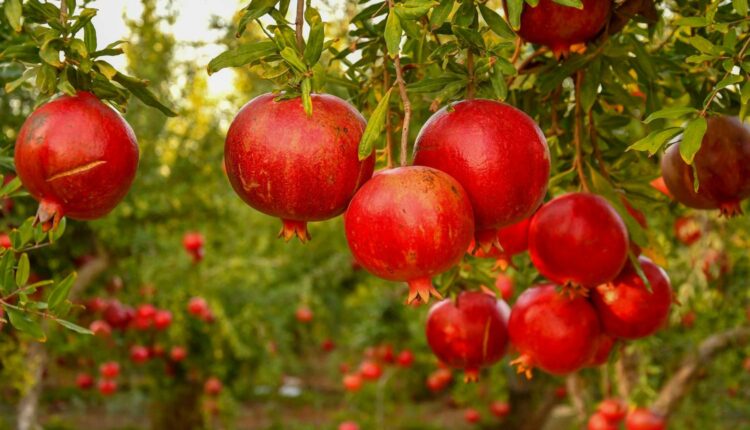©2021 Reporters Post24. All Rights Reserved.
It’s no wonder so many people enjoy pomegranate—they’re called the fruit of the gods, after all. Rich in vitamins and antioxidants, the juicy produce tastes divine, but the tree itself also exhibits stunning red, yellow, and orange flowers.
However, these fast-growing fruit trees need warmer temperatures to survive, so those in colder climates should grow these beauties indoors. Here, we spoke to experts about the best varieties for growing inside, as well as some step-by-step instructions for their planting and care.
- Growing a pomegranate tree indoors lets you enjoy its beautiful blooms and sweet fruit even in cold climates.
- Choose compact varieties like ‘Red Silk’ or ‘Nana,’ which thrive in containers and offer the best mix of size and fruit quality.
- To ensure success, use well-draining soil, give the tree plenty of sunlight, water moderately, and hand-pollinate blooms for fruit.
Best Varieties
When growing a pomegranate indoors, it’s important to consider how tall the tree will get. Many varieties that are grown outdoors, for example, can reach over 10 to 13 feet tall, says Nastya Vasylchyshyna, resident botany expert at Plantum—so they won’t be suitable for home environments.
“Red Silk is a great option, as it produces delicious, sweet, medium-to-large fruits and grows up to about 6 feet,” she suggests. “Its height can be kept even lower with regular pruning. Dwarf varieties usually have less tasty fruits, so Red Silk offers a good balance between fruit quality and tree size.”
Tammy Sons, founder and CEO of TN Nursery, prefers dwarf cultivars such as ‘Nana’ or ‘State Fair’. Nana is a small, decorative plant about 2 to 4 feet tall with bright red flowers, notes Vasylchyshyna. “The fruits are edible, but smaller and less juicy,” she says. “It’s a good choice if you prefer a more compact plant, and fruit flavor isn’t as important.”
How to Plant
Ready to get started on planting your pomegranate tree? These are the steps you should always follow, according to Vasylchyshyna:
- Choose your beginning: To grow a pomegranate at home, it’s best to use a sapling or root your own cutting. Growing from seeds takes much longer, and is less reliable.
- Root a cutting: Cut a hardwood stem about 10 inches long and one-third to one-half inch thick at the end of winter. Dip the fresh cut into rooting hormone powder to encourage root growth.
- Choose your container and soil: Take a pot with drainage holes, and fill it with a loose, well-draining soil mix. Moisten it evenly.
- Add your plant: Make a hole in the center of the soil with a pencil. This helps insert the cutting gently, without rubbing off the rooting hormone. Place about two-thirds of the cutting below the soil level, leaving two to three buds above the surface. Lightly press the soil around the cutting, but don’t pack it too tightly.
- Maintain humidity: Keep the soil consistently moist but not soggy. Cover the cutting with plastic wrap or a glass dome to maintain humidity and warmth. Occasionally, air it out to prevent mold, and make sure the soil doesn’t dry out completely.
- Provide diffused light: During rooting, avoid direct sunlight, and provide the plant with mild, diffused light.
Care Instructions
Once roots have formed, remove the cover, move the pot to a brighter location, and start watering a bit more often. Then, follow these care instructions:
Humidity
Avoid areas with very high humidity. Optimal humidity is around 50 to 55 percent.
Soil
Use a slightly acidic to neutral, nutritious potting mix, says Vasylchyshyna. Combine it with perlite and pebbles to improve drainage.
Water
Water regularly when the top layer of soil dries out, says Vasylchyshyna, keeping the soil consistently slightly moist. “Avoid over- and underwatering,” she adds, “or letting the soil dry out completely for a long time.”
Sun
Pomegranate trees need at least six hours of good sunlight, but eight to 10 hours is even better. Every couple of weeks, rotate the pot slightly in one direction so the plant receives even sunlight and doesn’t grow lopsided. “If you use a grow light, position it directly above the plant,” says Vasylchyshyna. “You won’t need to rotate the pot, as the lamp will mimic the sun.”
Fertilizing
Sons fertilizes her pomegranate tree once a month in the spring and summer. This helps with flowering and fruit production.
Pruning
“Light pruning in the spring keeps your pomegranate tree compact, healthy, and with lots of personality—even as an indoor plant,” says Sons.
Pollination
When growing a pomegranate indoors, natural pollinators can’t reach it—so you’ll need to pollinate the flowers by hand.
“Use a soft brush or cotton swab for this,” says Vasylchyshyna. “Collect pollen from the stamens of a male flower, which you can identify by its narrow base without swelling. Male flowers are often also slightly smaller and bell-shaped. Find a hermaphrodite flower with a noticeable swelling at the base, and place the pollen on the stigma in the center of the flower.”
Repeat this process every morning for all newly opened hermaphrodite flowers.
Harvesting
Harvesting can take some time. The interval may vary depending on the variety and growing conditions, but on average, Vasylchyshyna says it takes at least two to three years—and sometimes up to five years—for a pomegranate tree to produce fruit.
“Pomegranates don’t ripen after being picked, so don’t rush,” she says. “You know they’re ripe when the fruits become more angular, ribbed, and heavy. When tapped, they produce a metallic sound.”
Common Mistakes
If you want your tree to prosper, make sure to avoid these common pitfalls, as per Vasylchyshyna:
- Don’t skimp on the sunlight: If you want a good harvest, don’t place your pomegranate tree in dark corners—it will struggle to flower. Instead, use grow lights if you lack a bright window.
- Don’t expose the cutting to sudden, direct sunlight: Once your cutting has rooted, gradually move it closer to the light source over five to seven days to prevent stress.
- Don’t go overboard with watering: Excess moisture can cause root rot, so let the topsoil dry out between waterings. Pour out any excess water that collects in the saucer, and never let it sit there for long.


